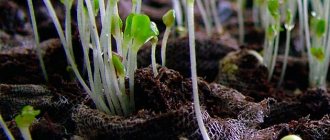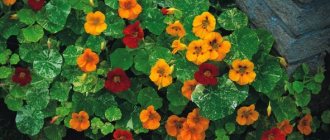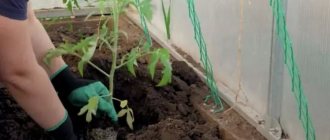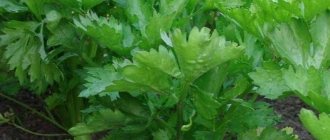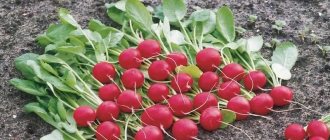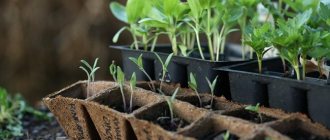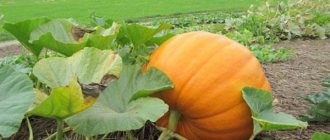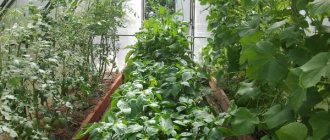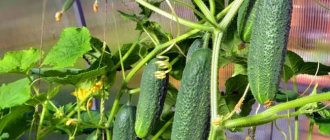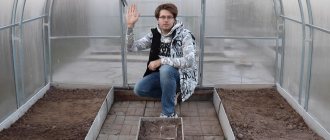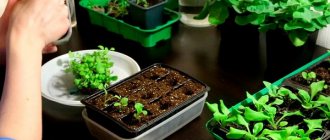International name:
Synonyms:
Characteristics:
| Complexity: |
| Development cycle: |
| Light mode: |
| Watering mode: |
| Temperature: |
| The soil: |
| Key Feature: |
Foliage color
Bud color
Dimensions Flower sizes
Taxonomy:
| Domain: |
| Kingdom: |
| Department: |
| Class: |
| Order: |
| Family: |
| Genus: |
Simply having a greenhouse on the site cannot guarantee that the seedlings in it will grow well and bring enviable results.
The main task for a gardener is to learn how to plant seedlings and grow them in greenhouse conditions, knowing about the many features of each type of plant.
Growing onions with lighting. Photo used as illustration. Source: Yandex.Images
Advantages of greenhouse cultivation
It is not for nothing that the construction of greenhouses is very popular. This is explained by a number of its positive properties:
- It is possible to grow various vegetables in areas with unfavorable climate;
- The harvest can be obtained not only in summer, but also at other times of the year;
- You can grow seedlings in greenhouses. This way it is possible not only to keep the root system intact, but also to save a significant amount of money on the purchase of seedlings;
- Thanks to the presence of an individual microclimate inside the greenhouse, it is possible to start planting even in winter, when the temperature outside is still unfavorable for plant growth;
- Due to the special material used to construct the structure, harmful ultraviolet radiation does not reach the seedlings;
- The soil dries more slowly, providing the plants with the right amount of moisture;
- Seedlings are not subject to strong temperature fluctuations, which ensures their safety.
Arrogance is the enemy of the summer resident
Some gardeners even decide to improve seeds, which are usually treated in advance and will not give positive results. The result will not be an amazingly rich harvest, but the loss of the possibility of seed germination.
In a greenhouse with seedlings, it is necessary to maintain temperature and humidity conditions
If you have any doubts about how the manufacturer prepared the seed, you can always refer to the information block on the back of the seed bag. The types of manipulations performed are usually indicated there.
Ignoring the importance of pre-sowing preparation is a reckless step on the part of a summer resident who decides to raise seedlings in a greenhouse. If self-harvested material is used for sowing, it must be prepared. Otherwise, you can expect the complete death of young shoots.
The whole point is that some infectious diseases can affect a crop not only due to poor-quality soil, but also due to poor, unprepared seed material. If treatment is not carried out, this will negatively affect:
- development of seedlings;
- their germination;
- health.
If seedlings are planted in the ground, they must be rotated annually.
Choosing a crop for planting
To understand which crop is best grown in a greenhouse, you need to pay attention to the following features:
- Cucumbers and tomatoes must be disease resistant;
- Preference should be given to early varieties of vegetables;
- All year round you can grow potatoes, cabbage, mushrooms, watermelons, melons, strawberries, zucchini, raspberries;
- Green onions, celery, and parsley also grow all year round in greenhouse conditions;
- Bell peppers, radishes, dill, cabbage, and spinach are also grown in greenhouses, but special conditions must be created for these crops.
Small greenhouse made of polycarbonate. Photo used as illustration. Source: Yandex.Images
Greenhouse options
Depending on the materials used for the construction of the structures described, they are divided into three types:
- Film ones are inexpensive. For installation there is no need to make a foundation, which simplifies the construction process, which anyone can master. A negative property of film greenhouses is their short service life, as well as unreliability;
- Glass perfectly transmits light and heat. They require a lot of skills, a strong frame and foundation to build the entire structure. If installed or used incorrectly, the glass may burst or break. Such greenhouses are not suitable for all seedlings, because on hot summer days the temperature in them becomes very high, which can lead to the death of plants;
- Polycarbonate is the most successful option for greenhouses. It is light in weight, has good strength, and provides seedlings with sufficient heat and light. Installation is simple. The finished structure has an attractive appearance and can serve its owner for about 20 years. Among the disadvantages are its high cost and flammability of the material.
Location
When deciding to place a greenhouse on your site, you need to thoroughly think through all the details of its correct location. It will depend on this whether it will be possible to create favorable conditions for the growth of seedlings.
The process of installing a polycarbonate greenhouse. Photo used as illustration. Source: Yandex.Images
When installing the structure being analyzed, you need to consider:
- Soil condition. The soil under the structure must be dense. If the entire area is clayey, you need to dig a pit under the greenhouse, fill it with sand, drainage, and then earth. Otherwise, the greenhouse will be very humid, which will cause damage to the plants. It is strictly prohibited to install a greenhouse on swampy or soft soil;
- Groundwater must be at a distance of at least 50 cm from the surface of the earth;
- The base must be level, without slopes;
- The greenhouse should not be installed near tall trees and bushes, because they will create shadows, preventing sufficient sunlight from entering;
- The location of the structure cannot be in a draft all the time. This will not make it possible to maintain the desired temperature inside the structure;
- Installation should be carried out close to water and electricity, which will ensure comfortable care of seedlings.
Reference! Access to the entrance to the greenhouse should be free and wide, without creating discomfort or inconvenience.
Greenhouse layout
First you need to prepare the soil for planting seedlings. These works are carried out before May. With proper planning of the greenhouse area, you can sow cold-resistant vegetables in it, as well as plant onions. These plantings should be placed so as not to initially interfere with the seedlings. The functions of compaction crops can then be performed. Plant cabbage seedlings or ornamental flower crops in a small area of the greenhouse.
Preparing and growing seedlings in a summer cottage.
If you want a more practical arrangement of plants in the greenhouse, you can save space in it by building special racks for placing seedlings on them. Boxes filled with fertile and well-drained soil are placed on the shelves. On top of the boxes you can install a frame on which to place a non-woven material that can create additional heating for the plants. Even a small sprout is enough to grow a good harvest of vegetables from it.
Planting dates for various plants
The plant can take root well and produce a harvest only if its individual planting dates are observed.
Young shoots. Photo used as illustration. Source: Yandex.Images
Age of seedlings: when to sow them?
Depending on the growing season, as well as the duration of development, all vegetables are divided into two groups:
- Deterministic – characterized by small size, short growing season, fruits ripen quickly. You can get a harvest from them 2 times a year. To do this, follow this scheme:
- If you plant seedlings in the spring, then the seeds should be sown in January or February;
- Planting in summer involves sowing in May.
- Indeterminate - they are large in size, the fruits grow and ripen for quite a long time, although the yield of these plants is higher. Seeds are sown in February.
Due to the fact that each vegetable grows differently, it is impossible to allocate specific planting dates for all. Disembarkation time depends on the following factors:
- Temperatures in the greenhouse;
- Conditions of the soil - it must warm up to the desired temperature;
- The appearance of the seedlings (can be seen by the leaves and stems);
- The ability of certain plants to withstand temperature fluctuations.
Reference! Eggplants and cucumbers are planted at night temperatures of at least 16 degrees, tomatoes and peppers - 14 degrees and above.
Strong and healthy cucumber seedlings.
Photo used as illustration. Source: Yandex.Pictures Most often, seedlings are planted during the following period:
- Tomatoes - from the beginning of May to the 10th of the same month. The seedlings are first grown in small cups for 45 days. During this period, it has a thick stem no less than 30 cm high and 6 leaves;
- Cucumbers - from May 10 to 15. Their age should be 20-25 days. The required number of leaves on a seedling is 2-3 pieces;
- Bell pepper - end of May. The suitable age for disembarkation is 70 days. The seedling must be at least 25 cm high, have a well-developed root, 8 leaves and buds with flowers;
- Eggplants - in early June. Their age is at least 50 days. The plant should have 6 or 7 leaves and a thick stem.
What can you plant in August? This time is good for broccoli, lettuce, tomatoes and cucumbers.
What is planted in April? This is a favorable time for planting radishes, herbs, lettuce and Chinese cabbage.
What to grow seedlings in?
Before growing seedlings, decide on containers for sowing seeds. They come in several types:
- cups;
- cassette;
- boxes;
- pots;
- peat tablets.
The choice depends on whether in the future you will engage in picking plants, that is, planting them separately from each other. If you are going to plant seedlings, you can first sow them in common pots or propagators. These are special transparent boxes equipped with heating. This method is the simplest and fastest. When the sprouts produce a second pair of leaves, they will need to be planted in separate cups or small pots.
If you are too lazy to spend time picking, it is better to plant several seeds in separate small containers. For this, cassettes, small pots or plastic glasses with holes in the bottom are used.
Peat tablets are one of the most convenient methods. A plant germinated in them can be immediately transplanted into the ground along with a tablet, which later decomposes in the soil.
How to grow and plant young shoots?
Regardless of what kind of vegetable it is, before sowing it in a greenhouse, you need to prepare the soil by fertilizing it and spraying it with special compounds that will resist the development of harmful microorganisms in the soil.
Recommendations
- Peppers are planted in a greenhouse at a temperature of 20 degrees, air humidity - 60%, soil humidity - 80%. Sprouts appear on the 4th day. For 7 days they are kept at a temperature of 16 degrees so that the seedlings do not grow upward very quickly. Peppers need to be watered, ventilated and loosened regularly.
- Cucumber seeds are soaked in clean water. The next day, the water is heated to 50 degrees and the seeds are kept in it for about 2 hours. Plant in pots with peat at a temperature of 20-25 degrees and a humidity above 80%. The soil needs to be loosened almost every day, watered with fertilizing (organic and mineral). The growing time for cucumber seedlings is 1 month.
- Tomatoes are planted at temperatures up to 25 degrees and humidity up to 65%. Water tomatoes only with cool water directly under the root without using fertilizer. To better harden the seedlings, the greenhouse is ventilated. The permissible temperature minimum is 12 degrees.
- White cabbage is planted in well-loosened soil fertilized with manure. Requires constant watering. Not afraid of frost. It is grown at temperatures from 10 to 20 degrees.
- Chinese cabbage loves abundant watering and a temperature of about 17 degrees.
- Cauliflower prefers a temperature of 16 degrees in soil well fertilized with organic compounds.
Watering tomatoes growing in a greenhouse.
Photo used as illustration. Source: Yandex.Pictures Caring for seedlings involves the following actions:
- Maintaining optimal temperature conditions in the greenhouse for each type of vegetable;
- When carrying out daily, regular ventilation, the air flow should not blow directly on the seedlings;
- When the seedlings have 2 leaves, they should receive watering consisting of water and nitroammophoska mineral fertilizers in a ratio of 3 liters to 2 teaspoons;
- Watering should be carried out only when the soil dries out (at 10 a.m.) to prevent plants from rotting;
- To make seedlings stronger, you need to use the mulching process;
- It is recommended to place a barrel of manure in one of the corners of the greenhouse, which will release carbon dioxide, which promotes better plant growth;
- Do not forget to tie up plants in time if necessary;
- When the temperature outside during the day does not fall below 18 degrees, the seedlings are hardened for 15 minutes a day, gradually increasing this time;
- Don’t forget to thin out the seedlings once a month, increasing the distance between them from 2 to 5 cm.
Soil preparation
Soil for seed germination must have the following properties:
- to be fertile;
- have a good structure;
- do not contain pest larvae, pathogens, or weed seeds;
- be sufficiently hydrated.
You can buy ready-made soil mixture at a specialty store or make it yourself. To do this you will need to perform a number of actions:
- Take 3 parts humus, 4 parts sand and 3 parts garden soil.
- Mix all the ingredients and sift through a sieve - this way you will saturate the earth with oxygen and break up unnecessary lumps.
- After this, disinfect the resulting substrate by heating it in a microwave oven or in a steam bath. This must be done in advance so that the natural microflora of the soil can be restored before planting the seeds.
- Having prepared the substrate, fill the containers with it. Pour in enough to leave 1 cm to the edge, then compact.
- After planting, the seeds of many crops are sprinkled with a thin layer of soil, but some are left open. Usually detailed directions are written on the seed packets.
Buy substances such as perlite or vermiculite. These minerals are excellent gardening aids. Adding them to the soil will make it fluffy, permeable and oxygenated. To eliminate moisture deficiency, add hydrogel to the soil.
